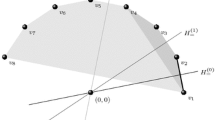Abstract
The generalization of classical results about convex sets in ℝn to abstract convexity spaces, defined by sets of paths in graphs, leads to many challenging structural and algorithmic problems. Here we study the Radon number for the P 3-convexity on graphs. P 3-convexity has been proposed in connection with rumour and disease spreading processes in networks and the Radon number allows generalizations of Radon’s classical convexity result. We establish hardness results and describe efficient algorithms for trees.





Similar content being viewed by others
References
Barbosa, R. M., Coelho, E. M. M., Dourado, M. C., Rautenbach, D., & Szwarcfiter, J. L. (2012) On the Carathéodory number for the convexity of paths of order three. SIAM Jounal on Discrete Mathematics, 26, 929–939.
Centeno, C. C., Dourado, M. C., Penso, L. D., Rautenbach, D., & Szwarcfiter, J. L. (2011). Irreversible conversion of graphs. Theoretical Computer Science, 412, 3693–3700.
Chellali, M., Favaron, O., Hansberg, A., & Volkmann, L. (2012). k-Domination and k-independence in graphs: a survey. Graphs and Combinatorics, 28, 1–55. doi:10.1007/s00373-011-1040-3.
Cook, S. A. (1971). The complexity of theorem-proving procedures. In Proc. 3rd ann. ACM sympos. theory computing, Shaker Heights, Ohio, 1971 (pp. 151–158). New York: ACM.
Dreyer, P. A., & Roberts, F. S. (2009). Irreversible k-threshold processes: Graph-theoretical threshold models of the spread of disease and of opinion. Discrete Applied Mathematics, 157, 1615–1627.
Duchet, P. (1988). Convex sets in graphs. II: Minimal path convexity. Journal of Combinatorial Theory. Series B, 44, 307–316.
Erdős, P., Fried, E., Hajnal, A., & Milner, E. C. (1972). Some remarks on simple tournaments. Algebra Universalis, 2, 238–245.
Farber, M., & Jamison, R. E. (1986). Convexity in graphs and hypergraphs. SIAM Journal on Algebraic and Discrete Methods, 7, 433–444.
Karp, R. M. (1972). Reducibility among combinatorial problems. In Complexity of computer computations (pp. 85–103). New York: Plenum.
Moon, J. W. (1972). Embedding tournaments in simple tournaments. Discrete Mathematics, 2, 389–395.
Parker, D. B., Westhoff, R. F., & Wolf, M. J. (2008). On two-path convexity in multipartite tournaments. European Journal of Combinatorics, 29, 641–651.
Radon, J. (1921). Mengen konvexer Körper, die einen gemeinsamen Punkt enthalten. Mathematische Annalen, 83, 113–115.
Varlet, J. C. (1976). Convexity in tournaments. Bulletin de la Société Royale Des Sciences de Liège, 45, 570–586.
van de Vel, M. L. J. (1993). Theory of convex structures. Amsterdam: North-Holland.
Acknowledgements
This work has been done in the context of the CAPES-DAAD PROBRAL project “Cycles, Convexity, and Searching in Graphs”. The first and fifth authors have been supported by CNPq and FAPERJ. The third author has been supported by FAPERJ. The sixth author has been supported by CAPES.
Author information
Authors and Affiliations
Corresponding author
Rights and permissions
About this article
Cite this article
Dourado, M.C., Rautenbach, D., dos Santos, V.F. et al. Algorithmic and structural aspects of the P 3-Radon number. Ann Oper Res 206, 75–91 (2013). https://doi.org/10.1007/s10479-013-1320-9
Published:
Issue Date:
DOI: https://doi.org/10.1007/s10479-013-1320-9




